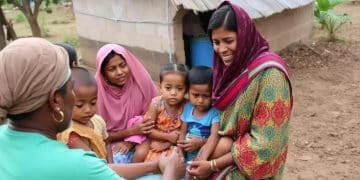Nutrition program outreach: improving community health

Nutrition program outreach connects communities to vital resources, empowering individuals with knowledge and access to healthier food options, ultimately improving overall health and well-being.
Nutrition program outreach plays a crucial role in improving the health of communities by increasing awareness and access to vital dietary resources. You might wonder how these programs reach those in need and create lasting change. Let’s dive into the components that make outreach successful.
Understanding nutrition program outreach
Understanding nutrition program outreach is essential for enhancing community health. These programs aim to connect individuals with nutritional resources and services that can vastly improve their well-being. By reaching out, organizations help people make informed choices about their diets, leading to healthier lifestyles.
The Goals of Nutrition Program Outreach
The primary goals of outreach initiatives include:
- Increasing awareness of available nutritional resources.
- Promoting healthy eating habits.
- Encouraging community involvement in nutrition-related activities.
Programs often work with local leaders to identify community needs. They engage in discussions that focus on dietary concerns, offering practical solutions that cater to diverse populations.
Methods of Outreach
Effective outreach requires various methods to engage different demographics. Some successful strategies include:
- Hosting workshops and events to provide hands-on education.
- Using social media to share tips and resources.
- Partnering with local schools and health clinics to spread the word.
Outreach methods should be adapted to suit the community’s preferences. For instance, some may benefit more from visual materials, while others might prefer interactive discussions.
Ultimately, the heart of nutrition program outreach lies in building relationships. Through trust and communication, facilitators can better serve their communities, ensuring that everyone has access to the nutritional support they need.
Key benefits of nutrition program outreach
When we discuss the key benefits of nutrition program outreach, it’s important to recognize how these initiatives can transform communities. Outreach programs not only spread awareness, but they also empower individuals to make healthier choices. By connecting people with vital resources, these programs play an essential role in improving public health.
Improved Access to Resources
One major benefit is the increased access to nutritional resources. Outreach efforts often provide:
- Information on local food banks and nutritional programs.
- Cooking classes that teach healthy meal preparation.
- Tips on budgeting for healthy foods.
These resources are crucial for individuals who may not know where to find help or how to utilize available programs effectively. When communities are informed, they can take better control of their health.
Enhanced Community Engagement
Another significant advantage is enhanced community engagement. Outreach initiatives foster connections among residents, creating a supportive environment. With more people participating, there is:
- Increased collaboration among local organizations.
- Opportunities for sharing knowledge and resources.
- Stronger community ties that encourage healthy behaviors.
As individuals come together, they create a network of support, making it easier to sustain healthy habits. Furthermore, community involvement in nutrition programs often leads to a sense of ownership over health initiatives.
Ultimately, the benefits of nutrition program outreach stretch beyond just dietary improvements. They pave the way for healthier, more informed communities that can thrive together. Investing in outreach is investing in overall community well-being, generating a ripple effect that enhances lives.
Strategies for effective outreach

Implementing strategies for effective outreach can significantly enhance the impact of nutrition programs. These strategies are designed to reach diverse populations and ensure that services are accessible to everyone in the community. By understanding the best practices for outreach, organizations can create more meaningful connections.
Identify Target Audiences
The first step in effective outreach is to identify target audiences. Knowing who you want to reach allows for tailored messaging and programs that resonate. Consider factors such as:
- Age and demographic characteristics.
- Specific dietary needs or preferences.
- Cultural backgrounds that influence eating habits.
By focusing on these elements, outreach can become more relevant and engaging for each group.
Utilize Multiple Communication Channels
Using various communication channels is vital for broadening outreach efforts. Different people respond to different types of messages. Effective communication strategies include:
- Social media campaigns to engage younger audiences.
- Community flyers and posters in accessible locations.
- Partnerships with local organizations, such as schools and nonprofits.
By diversifying the methods of communication, outreach can become more inclusive and effective.
Moreover, maintaining consistent messaging across all platforms reinforces the importance of nutrition and increases engagement. Strategies for effective outreach hinge on collaboration and creativity, making use of community resources to foster lasting change.
Eventually, feedback from the community can shape ongoing strategies. Engaging with participants directly helps refine outreach methods and ensures that they meet the needs and preferences of those they aim to serve.
Challenges faced in nutrition outreach
Nutrition outreach programs face various challenges that can hinder their effectiveness. Understanding these obstacles is crucial for developing strategies to overcome them. One common issue is reaching underserved communities, often due to limited resources and accessibility.
Limited Funding and Resources
Many outreach programs struggle with funding. Limited budgets can restrict the scope of activities, making it difficult to provide comprehensive services. Some specific challenges include:
- Inadequate staff training and support.
- Reduced availability of materials and resources.
- Challenges in promoting initiatives effectively due to budget constraints.
Without sufficient funding, outreach efforts often fall short, limiting their impact on community health.
Language and Cultural Barriers
Another significant challenge in nutrition outreach is navigating language and cultural differences. Effective communication is essential for engagement. Barriers may include:
- Difficulty in translating materials to meet diverse language needs.
- Cultural misconceptions about health and nutrition.
- Resistance to messages that do not align with local customs or traditions.
To truly connect with communities, it’s vital for outreach programs to be culturally sensitive and inclusive. Tailoring messages to fit the community’s values can enhance engagement.
Additionally, there is often a lack of awareness about available resources within communities. Many individuals may not know what services are offered or how to access them. Awareness campaigns can help, but they require careful planning and execution to be effective.
Addressing the challenges faced in nutrition outreach is essential for creating impactful programs. By acknowledging these issues and working towards solutions, organizations can build stronger connections within their communities and promote healthier lifestyles.
Success stories in community nutrition programs
Success stories in community nutrition programs illustrate the profound impact such initiatives can have on individuals and families. These stories often highlight how effective outreach and support can lead to healthier lifestyles and improved community well-being.
Case Study: The Fresh Start Initiative
One successful program is the Fresh Start Initiative, which operates in several urban neighborhoods. This program has created a sustainable model for providing fresh produce to low-income families. Through partnerships with local farmers and grocery stores, participants have access to affordable fruits and vegetables. The results have been promising:
- Increased fruit and vegetable consumption among participating families.
- Improved overall health metrics, such as reduced obesity rates.
- Strengthened community bonds through shared cooking classes.
This initiative shows how access to nutritious food can lead to significant health improvements.
Empowerment through Education
Another inspiring success story comes from community education workshops focused on food preparation and nutrition. Many participants have reported feeling empowered to take charge of their health. These workshops not only teach cooking skills but also provide:
- Information on meal planning and budgeting.
- Strategies for making healthier choices.
- Community support networks that encourage accountability.
As a result, many families are now choosing healthier foods and preparing meals at home, which fosters a stronger connection to nutrition.
Success stories in community nutrition programs like these serve to inspire other communities. They demonstrate that with the right resources and support, positive changes are achievable. Such initiatives can create ripple effects, encouraging a culture of health and wellness that benefits everyone.
FAQ – Frequently Asked Questions about Nutrition Program Outreach
What is the main goal of nutrition program outreach?
The main goal is to connect individuals and families with resources and education that promote healthier eating and improve overall community health.
How can I get involved in my local nutrition outreach programs?
You can get involved by volunteering your time, participating in events, or donating resources to support these programs in your community.
What challenges do nutrition outreach programs face?
Common challenges include limited funding, reaching underserved populations, and overcoming language and cultural barriers.
Can you share an example of a successful nutrition outreach initiative?
One example is the Fresh Start Initiative, which provides fresh produce to low-income families and has shown improvements in health and community engagement.





